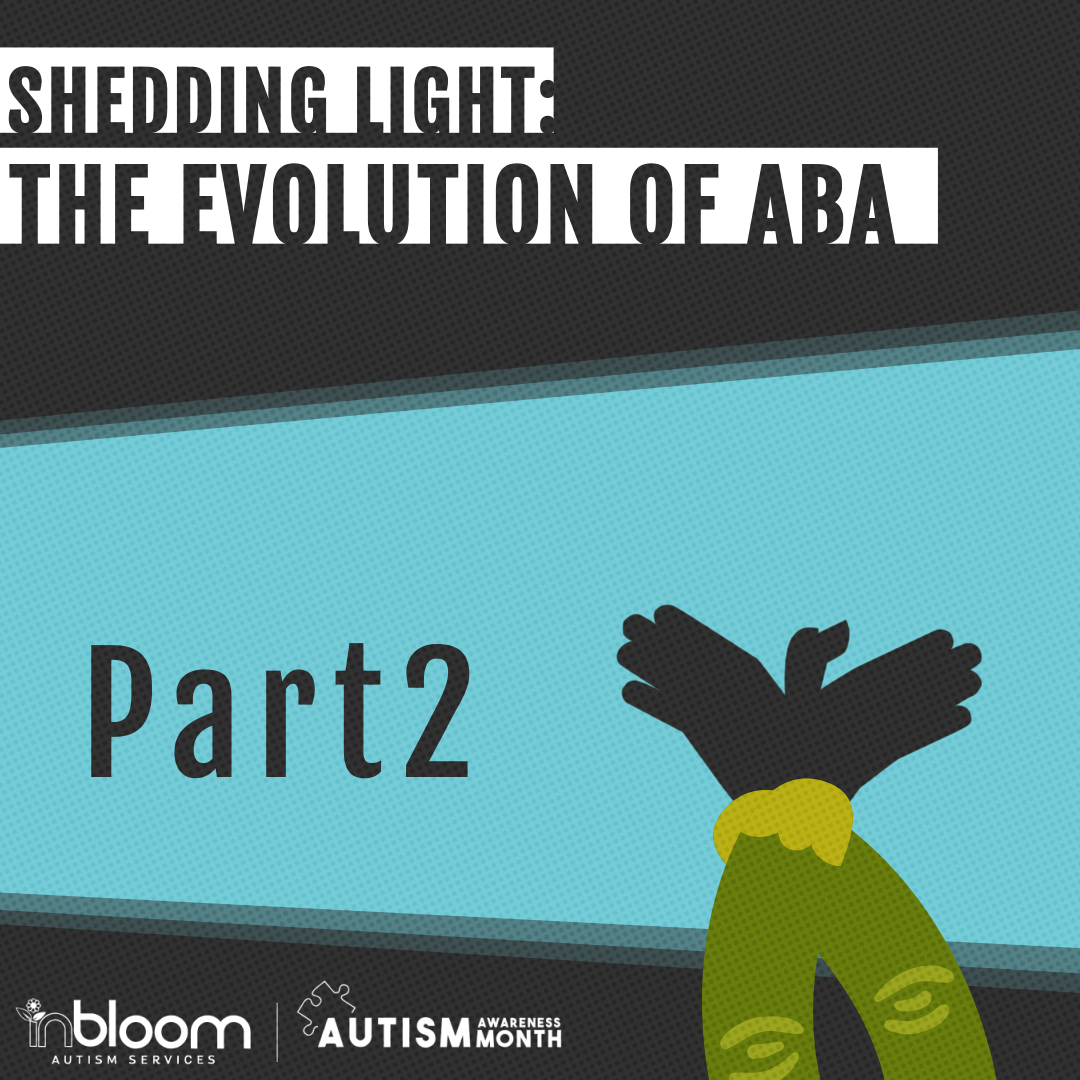The History of ABA (Applied Behavior Analysis)

ABA has become one of the most effective, evidence-based approaches for supporting children with autism. Like any science-backed therapy, it didn’t appear overnight; it developed through decades of research, experimentation, and refinement.
Understanding the history of ABA provides parents and caregivers with valuable context for how modern therapy practices came to be and why ABA continues to evolve today.
First, what is applied behavior analysis?
Applied behavior analysis is a scientific approach to understanding and improving human behavior. By focusing on observable actions and using reinforcement-based strategies, ABA helps children build communication, social, and daily living skills.
How ABA is used in autism treatment today
Today, ABA therapy is widely recognized as the gold standard for autism treatment.
At InBloom Autism Services, clinicians use individualized ABA programs to encourage positive behaviors, reduce behaviors that interfere with learning, and support long-term independence for children with autism. Families are involved at every step through ABA behavior consultation and parent training, ensuring therapy is meaningful at home and beyond.
Origins of applied behavior analysis
The story of ABA begins long before it became a clinical field. In the early 1900s, psychology was focused on thoughts and feelings; things that couldn’t be observed or measured.
Early roots in behaviorism
In the 1920s, psychologist John B. Watson introduced behaviorism, a new school of thought that shifted the field away from unobservable ideas and toward measurable actions. Soon after, Ivan Pavlov expanded on this concept with his famous dog-and-bell experiment.
At first, Pavlov’s dog salivated only when food was presented. Pavlov then rang a bell each time he brought out the food. Over time, the dog began to salivate at the sound of the bell alone, even when no food was given.
This finding demonstrated classical conditioning, showing that responses can be learned through association with environmental cues. These early discoveries laid the groundwork for applied behavior analysis by proving that behavior can be observed, measured, and shaped.
Today, ABA therapists use the same principles to help children with autism learn new skills in supportive, family-centered ways.
Key Researchers and Pioneers of ABA
While Watson and Pavlov introduced the first ideas of behaviorism, B.F. Skinner expanded the field with his theory of operant conditioning. Skinner showed that voluntary actions could be strengthened by rewards or reduced by consequences. For example, children are more likely to repeat a behavior, like saying “thank you,” when it consistently leads to praise or another positive outcome.
These discoveries attracted a new generation of researchers, including Dr. Ole Ivar Lovaas, who would later apply behavioral principles directly to children with autism. Together, these pioneers laid the foundation for Applied Behavior Analysis as both a science and a therapy.
Who created ABA Therapy?
Applied behavior analysis didn’t emerge overnight or from the work of just one person. Instead, it developed over decades as researchers built on one another’s discoveries, gradually shaping ABA into the structured, evidence-based therapy that supports children with autism and their families today.
The role of B.F. Skinner and early behavior analysts
B.F. Skinner’s research in the mid-20th century emphasized reinforcement as a means of shaping voluntary behavior. Early analysts adapted his ideas to practical settings, laying the foundation for ABA’s use in schools, clinics, and homes.
Foundational ABA experiments and milestones
In the 1960s, Dr. Ole Ivar Lovaas pioneered the application of ABA for autism therapy. His 1987 study, archived at the National Library of Medicine, reported that 90% of children receiving intensive ABA therapy showed significant improvement compared with a control group.
While some of his early methods are no longer used, this research demonstrated ABA’s potential and secured its place as a leading treatment option.
A timeline of ABA development
The growth of ABA can be traced through key decades of discovery, research, and clinical application. Understanding this timeline shows how the field moved from experimental studies to a trusted therapy used worldwide today.
ABA in the 1960s: The initial foundations
- Lovaas introduces the “Lovaas Method,” applying behavioral science to autism treatment.
- 1968: The Journal of Applied Behavior Analysis (JABA) launches, establishing ABA as a recognized scientific field.
Growth of ABA therapy in the 1980s–1990s
- ABA research expands and gains recognition as an effective therapy for autism.
- 1987: Lovaas publishes his landmark study on intensive ABA therapy.
- 1990s: ABA begins influencing special education programs across the U.S.
Modern ABA therapy and evidence-based practice
- 2000s–Today: ABA evolves into a flexible, ethical, family-centered therapy.
- Play-based and naturalistic approaches make sessions engaging and child-friendly.
- Providers like InBloom Autism Services carry forward this evidence-based legacy with compassionate, individualized care.
The evolution of ABA therapy
As science advanced, ABA shifted from early approaches to more ethical, compassionate, and family-centered practices. These changes reflect the field’s commitment to adapting to children’s needs while maintaining strong results.
Shifts in techniques and interventions
Early ABA sometimes relied on punishment-based methods, but these are no longer considered acceptable. Today, ABA emphasizes positive reinforcement, skill-building, and safe, evidence-based techniques that encourage children to learn and thrive.
How ABA therapy was adapted for autism treatment
Modern ABA focuses on teaching meaningful skills, such as communication, self-advocacy, and daily living tasks, that directly improve quality of life. For example, a child might learn to request a break rather than engage in unsafe behaviors when overwhelmed.
Milestones in applied behavior analysis
Throughout its history, ABA has achieved significant milestones in research, education, and therapy. These landmarks highlight how ABA became one of the most recognized approaches for autism support.
Academic recognition and clinical use
As ABA gained momentum, it became increasingly recognized by the academic community and integrated into clinical practice.
These milestones helped shape ABA into a respected, evidence-based field:
- 1968 – Launch of JABA: The Journal of Applied Behavior Analysis (JABA) was first published, giving ABA a formal academic platform. This legitimized the field and provided researchers with a peer-reviewed outlet for sharing findings.
- 1980s–1990s – Growing Clinical Acceptance: During these decades, multiple studies confirmed ABA’s effectiveness for children with autism and other developmental needs. As a result, ABA became more widely adopted in schools, clinics, and home programs across the United States.
The role of ABA in special education and therapy
By the 1990s, ABA principles were integrated into special education, helping children succeed academically and socially. Today, ABA is endorsed by the U.S. Surgeon General and the American Psychological Association as an evidence-based treatment.
ABA therapy today
ABA continues to evolve, drawing on decades of research while embracing modern best practices.
Current best practices in ABA
Therapy today is individualized, play-based, and guided by a child’s interests. Programs are built around positive reinforcement and naturalistic teaching to keep learning fun and engaging.
How ABA continues to evolve
Research and clinical practice ensure ABA stays dynamic. Advances include parent training, technology-based supports, and flexible service models such as behavior consultation and direct therapy.
InBloom Autism Services’ role in continuing the legacy of ABA therapy
At InBloom Autism Services, we are proud to continue the legacy of ABA by blending evidence-based methods with compassion and family collaboration. Our team provides services such as direct ABA therapy and caregiver training, ensuring that families have the tools they need for long-term success.
If you’re ready to see how ABA can help your child, contact us today.
Frequently asked questions about the history of ABA
Parents often wonder how ABA developed and why it’s considered so effective. Here are answers to some of the most common questions about its history.
Experiments by researchers such as Watson, Pavlov, and Skinner showed that behavior could be taught and changed, laying the foundation for ABA strategies.
ABA grew out of behaviorism, which emphasized studying observable actions and how the environment shapes learning.
ABA gained traction in the late 1980s after Lovaas’s research showed significant improvements for children receiving intensive therapy.
Yes. Early methods sometimes included aversive techniques, but today’s ABA emphasizes positive reinforcement and family-centered care.
ABA is now widely respected as an evidence-based therapy that helps children with autism build independence and confidence.
Peer-reviewed research has always guided ABA, validating its methods and driving continued improvements in therapy.
Learning about the history of ABA therapy helps parents appreciate how far the field has come and why today’s practices are safe, compassionate, and effective.
Absolutely. New hires receive a paid two-week onboarding program, along with weekly supervision, hands-on coaching, and ongoing professional development opportunities such as CEUs.



